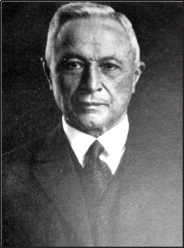- JUNKERS
- GERMANY (see also List of Individuals)\
 3.2.1859 Rheydt/D - 3.2.1935 Gauting-Munich/D\Hugo Junkers graduated as a mechanical engineer from Aachen University in 1883 after having also studied in Berlin and Karlsruhe. He first developed a counter-piston engine. Then Junkers developed the gas calorimeter such that he was in 1897 appointed professor of the theory of heat at Aachen University, a position he held until 1911 when he decided to devote his future entirely to aviation.\Junkers had indeed founded in 1895 a company which manufactured metal products including his gas-powered hot-water heaters. A visit of the Wright brothers to Europe in 1908 aroused his interest in flight and he was granted in 1910 a patent for a flying wing. It corresponded to a novel design requiring neither fuselage nor external bracing wires. He also built the conventional Junkers J1 entirely of iron and steel, with a first flight in 1915. Because of the low speed, Junkers then used exclusively the by then available aluminium for the J4, which entered service in 1917. To stiffen the thin aluminium-alloy skins, Junkers used corrugations running fore and aft, a feature of his aircraft for the next 20 years. After World War I Junkers converted to commercial aviation and produced a single-engined low-wing monoplane capable to carry four passengers in an enclosed cabin. The F13 is generally accepted to be the first airliner of which over three hundred were used worldwide. The Ju52 was originally a single-engine airplane released in 1930 and the three-engined version flew in 1932, and was later extensively used by Germany's Luftwaffe. Junkers also started with the flap set aft of the trailing edge of the wing which is known as Junkers' flap. Also, he presented in 1929 the G38 airliner, then the largest airplane worldwide with a span of 44 m. Its wing was so thick that some of the 34 passengers could sit in the wing and look out through windows in the leading edge.\Anonymous (1920). Männer der Luftfahrt: Hugo Junkers. Illustrierte Flug-Welt 2: 350-351. PAnonymous (1935). Hugo Junkers. The Aeroplane 48: 146. PAnonymous (1996). Junkers, Hugo. Biographical dictionary of the history of technology: 390,L. Day, I. McNeil, eds. Routledge: London.Behrsing, G. (1974). Junkers. Neue Deutsche Biographie 10: 695-697. Duncker & Humblot: Berlin. Berson, A. (1929). Junkers Festschrift zum 70. Geburtstag. VDI-Verlag: Berlin.Blunck, R. (1942). Hugo Junkers: Der Mensch und das Werk. Limpert: Berlin. PJunkers, H. (1923). Metal aeroplane construction. Journal Aeronautical Society 27(9): 406-449. Nägel, A. (1935). Hugo Junkers. Zeitschrift des Vereines Deutscher Ingenieure 79(10): 314-315. PWagner, W. (1996). Hugo Junkers Pionier der Luftfahrt. Bernard&Graefe: Bonn. P
3.2.1859 Rheydt/D - 3.2.1935 Gauting-Munich/D\Hugo Junkers graduated as a mechanical engineer from Aachen University in 1883 after having also studied in Berlin and Karlsruhe. He first developed a counter-piston engine. Then Junkers developed the gas calorimeter such that he was in 1897 appointed professor of the theory of heat at Aachen University, a position he held until 1911 when he decided to devote his future entirely to aviation.\Junkers had indeed founded in 1895 a company which manufactured metal products including his gas-powered hot-water heaters. A visit of the Wright brothers to Europe in 1908 aroused his interest in flight and he was granted in 1910 a patent for a flying wing. It corresponded to a novel design requiring neither fuselage nor external bracing wires. He also built the conventional Junkers J1 entirely of iron and steel, with a first flight in 1915. Because of the low speed, Junkers then used exclusively the by then available aluminium for the J4, which entered service in 1917. To stiffen the thin aluminium-alloy skins, Junkers used corrugations running fore and aft, a feature of his aircraft for the next 20 years. After World War I Junkers converted to commercial aviation and produced a single-engined low-wing monoplane capable to carry four passengers in an enclosed cabin. The F13 is generally accepted to be the first airliner of which over three hundred were used worldwide. The Ju52 was originally a single-engine airplane released in 1930 and the three-engined version flew in 1932, and was later extensively used by Germany's Luftwaffe. Junkers also started with the flap set aft of the trailing edge of the wing which is known as Junkers' flap. Also, he presented in 1929 the G38 airliner, then the largest airplane worldwide with a span of 44 m. Its wing was so thick that some of the 34 passengers could sit in the wing and look out through windows in the leading edge.\Anonymous (1920). Männer der Luftfahrt: Hugo Junkers. Illustrierte Flug-Welt 2: 350-351. PAnonymous (1935). Hugo Junkers. The Aeroplane 48: 146. PAnonymous (1996). Junkers, Hugo. Biographical dictionary of the history of technology: 390,L. Day, I. McNeil, eds. Routledge: London.Behrsing, G. (1974). Junkers. Neue Deutsche Biographie 10: 695-697. Duncker & Humblot: Berlin. Berson, A. (1929). Junkers Festschrift zum 70. Geburtstag. VDI-Verlag: Berlin.Blunck, R. (1942). Hugo Junkers: Der Mensch und das Werk. Limpert: Berlin. PJunkers, H. (1923). Metal aeroplane construction. Journal Aeronautical Society 27(9): 406-449. Nägel, A. (1935). Hugo Junkers. Zeitschrift des Vereines Deutscher Ingenieure 79(10): 314-315. PWagner, W. (1996). Hugo Junkers Pionier der Luftfahrt. Bernard&Graefe: Bonn. P
Hydraulicians in Europe 1800-2000 . 2013.
